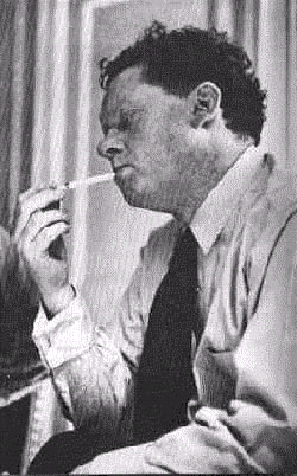DYLAN THOMAS' MOST FAMOUS WORK
Under Milk Wood

Dylan Thomas' most famous work Under
Milk Wood, published in 1954, is not only Dylan Thomas' last work but
also his most famous one. During the last months of his life he rearranged
it several times. On October 15, 1953, he finally gave the finished manuscript
to the BBC and died just a few weeks later on November 9, 1953. The subtitle
"A Play for Voices" explains the genre of Thomas's work very
well. Regarded outwardly it is a radio play, but don't expect it to be
a traditional radio play. Actually we have to speak of a mixture of different
text types: drama, narrative and song. Under Milk Wood is set in a fictitious
Welsh town, named Llareggub. Actually the name really sounds Welsh but
as a matter of fact it is an anagram of the rude expression "bugger
all." The play deals with the life of Llareggub's inhabitants from
the middle of one night to the middle of the next. There is no main action
but different episodes which are connected by the narration of two omniscient
narrators, the first and the second voices. These voices just "switch"
from scene to scene or better from character to character. They do not
actually belong to the people of Llareggub but introduce them to the listener.
So they are mediators between the drama sections and the audience.
During the play we get to know about many of Llareggub's inhabitants.
There is Captain Cat, a blind sea captain, who dreams of his long-drowned
mates and then there are Miss Price and Mr. Mog Edwards, courting each
other. We learn about Mrs. Ogmore-Pritchard who killed her two husbands
by hygiene and about Mr. Pugh who plans to poison his wife, just to name
a few of them. The single episodes are only related to each other by the
fact that all characters live in the same town, maybe also by the fact
that none of them is really innocent. Even the children seem to be spoilt
as they play games in which the boys must either kiss a girl or give her
a penny. Also the love between Miss Price and Mr. Edwards cannot be seen
as a pure love for Edwards hears "the bells of the tills" when
thinking of their wedding. After all, what is really special about Under
Milk Wood, is Thomas' complex imagery. The line of "the sloeblack,
slow, black, crowblack, fishingboat-bobbing sea" first seems to be
an arbitrary collection of words but in fact all of them refer to the
subject 'sea' and make sense. However the inventively poetic language
of the two narrators which is so rich in imagery contrasts with the plain
and ordinary language of the inhabitants.With Under Milk Wood Dylan Thomas
brought sound and sense together in a new way. This is not in the least
one of those radio plays you can simply enjoy in your armchair. In fact
the action is less important than the poetry, the overflowing - maybe
overloaded - imagery and the running rhythm of Thomas' language. As it
seems to be almost impossible to understand each and every metaphor, you
should just listen and feel the rhythm! "Listen. It is night moving
in the streets, the processional salt slow musical wind in Coronation
Street and Cockle Row, it is the grass growing on Llareggub Hill, dewfall,
starfall, the sleep of birds in Milk Wood."
Dana Kestner